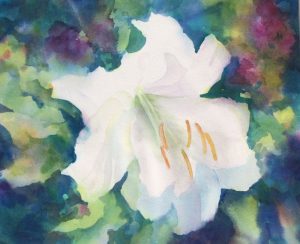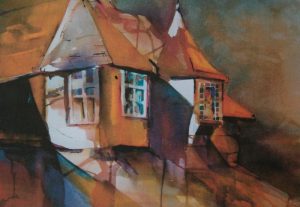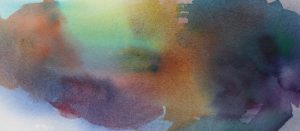THERE ARE NO BAD PIGMENTS, JUST WRONG TIMES TO USE THEM! That statement is a cornerstone of my teaching of pigments or, another way of saying it is: “why do I need four blues?”
 A little history:
A little history:
In the late 70’s, early 80’s I spent several years painting with just the 3 primaries:
- Winsor or cadmium yellow light;
- pthalo blue;
- alizeran crimson.
We were glazing and achieving beautiful color effects, as long as we didn’t go into the darker values. When I tried to paint in darker values I didn’t like the flat matte colors that resulted.

“Buster” – painted in a Schink class with just sedimentary pigments
Because of this frustration, I was excited to learn from Christopher Schink how his teacher, Barse Miller, divided pigments up into “staining, opaque, and transparent.” But they painted with one or the other depending on the subject matter, i.e., stains for bright subjects, opaques for scenes like waterfronts (and cowboys), and transparents for more delicate subjects. From Robert Wood, I discovered how to glaze a strong stain with a strong opaque to get a more color-filled dark.
for more delicate subjects. From Robert Wood, I discovered how to glaze a strong stain with a strong opaque to get a more color-filled dark.
Expanding on these two insights, I have developed a useful way to decide when you should use what (and why). It should clarify any confusion you have.

colorful darks

The Joker. Having fun with sedimentary over dyes.
The rules are simple enough and we will explore how to implement them. You will know why you have at times ended up with “mud” instead of clear colors and how to avoid this trap. You will know why you probably should have four blues on your palette, but no “granulating” paints. In addition, you will discover the fun of cutting through a sedimentary pigment with a stain (which you want this effect) and turning riotous oranges and yellows into cool, dark color-filled shadows.
There are times when the use of stains (now referred to as DYES) is the best choice. The opaques are renamed SEDIMENTARY. There is an right and a wrong time to use them too. And since all watercolors are transparent, I’ve renamed that small group LUMINOUS.

Iris. Painted in three primaries.
Knowing and understanding the the role of the pigment quality in choosing which blue you use… or any other color … is empowering in your quest to become a better artist.

Equipment
Since the class is about pigments, bring as many colors as you want. Bring your palette(s) and any extra tubes of paint you have, particularly some of the “weird” ones you have. You can see my standard palette in links.

Sedimentary pigments
